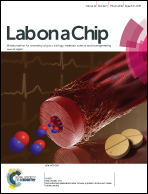Frequency tracking in acoustic trapping for improved performance stability and system surveillance†
Abstract
This work proposes and demonstrates an acoustic trapping system where the trapping frequency is automatically determined and can be used to analyse changes in the acoustic trap. Critical for the functionality of this system is the use of a kerfed transducer that removes spurious resonances. This makes it possible to determine the optimal trapping frequency by analysing electrical impedance. It is demonstrated that the novel combination of a kerfed transducer and acoustic trapping in glass capillaries creates a high Q-value resonator. This narrows the frequency bandwidth but allows excellent performance, as confirmed by a ten-fold increase in the flow retention speed when compared to previously reported values. Importantly, the use of automatic frequency tracking allows the use of such a narrow bandwidth resonator without compromising system stability. As changes in temperature, buffer-properties, and the amount of captured particles will affect the properties of the acoustic resonator, corresponding changes in resonance frequency will occur. It is shown that such frequency changes can be accurately tracked using the setup. Therefore, monitoring the frequency over time adds a new feature to acoustic trapping, where experimental progress can be monitored and the amount of trapped material can be quantified.


 Please wait while we load your content...
Please wait while we load your content...